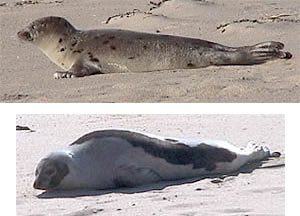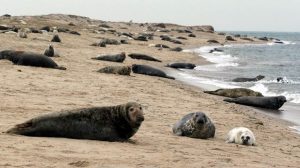Cape Cod Seals

NMFS Permit No. 775-1600-10
The word pinniped (fin footed) refers to animals of like appearance, not relatedness. Pinnipeds describe any carnivorous, amphibious mammal with front and hind appendages modified into flippers. Seals, sea lions and walrus, with over 30 species worldwide, fit the description, and are often lumped together.
Different species of seals occupy northwest Atlantic waters, but only two types remain throughout the year; Harbor and gray seals are often sighted throughout the year in the water and resting on shore in large groups or herds. Both species are abundant throughout coastal New England.
Three other species which birth in areas such as Canada and Greenland are harp, hooded and ring seals. These animals may migrate to NE.
Harbor seals (Phoca vitulina vitulina) and gray seals (Halichoerus grypus atlantica), are the most commonly spotted seals on Stellwagen Bank. Highly adaptable and widespread, they are also found in the subarctic and temperate areas of the Pacific and Arctic oceans.
At sea, harbor seals and gray seals are usually found alone or in small, very loose groups that reduce competition while foraging. On Stellwagen Bank, it is believed that they feed mostly on sand lance and herring. On land, they often gather at low tide on sandy or rocky beaches, preferably islands, where they can scan the environment for danger.
For information on how to protect seals and become a responsible seal observer, please responsible seal watching please read the Northeast Seal Watching Guidelines.

A female harbor seal hunting sand lance.
NMFS Permit No. 775-1600-10
Harbor seals are relatively small (1.5 meters, or 5 feet long), with a coat that varies somewhat with age, wetness and between individuals. Some pups are born with a light colored, lanugo coat (fetal fur that most mammals shed before birth). The lanugo coat is shed within a few weeks of birth. Most seals, though, are born with an adult coat that darkens with age.
Females in this area usually give birth in late spring and early summer. It is thought that females from Massachusetts migrate to quiet islands in New Hampshire and southern Maine to pup. Historically, harbor seals pupped in Massachusetts, and there are increasing sightings of very small pups here in May and June. Pups are able to swim within minutes after birth and can travel with the female while she hunts. On Stellwagen, small pups are often found treading water while waiting for mom to return from a dive.
Adults of both sexes are similar in appearance, with lighter undersides, brown to gray topsides and differing amounts of irregular spots throughout. Harbor seals’ front flippers have relatively small claws, and the claws of their hind flippers are tiny. At sea, they can be hard to spot. Only their heads are visible as they come up for air, their snouts are small and pointed, and they have a small but definite brow. If you have binoculars, you can spot ear openings just behind the eyes.
Gray seal breeding colony on Muskeget Island.
NMFS Permit No. 775-187
Gray seals, Halichoerus gypus, are the largest seal found in the area, with males growing to 8 feet and weighing over 800 pounds (2.3 m. and 300-350 kg.). Females are somewhat smaller, measuring 7 feet and weighing less than 600 pounds (2 m. and 150-200 kg.). Besides size, the sexes differ in a number of ways: males tend to be darker with few light spots, while females tend to be light with dark, irregular blotches. Young can be easily confused with harbor seals. With a head-on view, gray seals have wide-set nostrils that form a W, while harbor seals have close-set nostrils that form a small V. Sometimes called horseheads, gray seals of both sexes have broad, long snouts that become more pronounced, especially in males.
Gray seals are endemic to the North Atlantic, ranging from the Baltic,western Europe to Canada and Northeastern United States. In recent years, the number of gray seals in New England seems to have grown. It is not yet clear if the Canadian population is simply growing and moving south, or if there are other, environmental factors at work.
Highly gregarious, gray seals are often found in large groups hauled out on quiet sand or rock beaches for rest and breeding. Females in this area, such as Monomoy Island in Nantucket Sound, give birth to one, white-coated pup from late December to mid February. The pup is nursed intensively for about 15 to 20 days on an increasingly fatty milk. Females come into estrus about 2 weeks after weaning their pups. Males are highly competitive over access to groups of females on shore. After fertilization, the embryo stops development and “rests” for 3 to 4 months before development resumes (delayed implantation).

Harp seals, Pagophilus groenlandicus, grow to about ameter and a half, weighing about 130 kg. (5.5 feet and 280 pounds). Usually they have light gray or white coats marked with dark brown patches about the head and back. These dark markings may form a U on the back, much like the base of a hand held, musical harp. Young animals go through a complicated series of molts, changing from infant “whitecoats” (principal aim of the annual Canadian seal hunt) to “bedlamers” and “spotted harps” of the juveniles.
Despite the fact that harp seals are considered a northern species, dependent upon pack ice habitats for pupping, sightings of juveniles in the southern Gulf of Maine have increased in the last decade, during the winter months. Sightings of adults are less common but increasing.

Unspotted coat of a “blueback”: juvenile hooded seal. NMFS Permit No. 775-1600-10
Hooded seals, Cystophora cristata,are somewhat sexually dimorphic in size, with males reaching 2.5 m. and 300 kg. (8 feet, 600 pounds) and females reaching 2m. and 160 kg. (7 feet, 350 pounds). In form though, the sexes are quite different: males have an inflatable sac drooping from the top of the nose.
When inflated, it forms a black, oval hood. Further, they can inflate the red, inner lining of the nose out of one nostril. This spectacular display may be used to reduce actual fighting during conflicts with other seals. Adults are silvery blue or white with irregular dark brown patches. Juvenile stages include the handsome “blueback” of first year animals: bluish gray on the back, cream colored belly and dark flippers and mask.

Note the blunt-nosed profile and
dark face of juvenile hooded seal.
NMFS Permit No. 775-1600-10
In this area, hooded seals are a rare sight. They share much of their range with harp seals but give birth on pack ice, a little later (last two weeks of March). Young are nursed for a mere four days and may double their birth weight by weaning. Most sightings locally are of the young of the year.
Ringed seals, Phoca hispida, are the smallest seal to make an appearance in this area at about 1.5 m. long and 70 kg. in weight (4.5 feet and 150 pounds). Males and females differ little and their mass changes radically throughout the year, especially during the molt when animals are unable to feed. They are generally dark gray above and cream below with a constellation of light rings scattered across the head and back.Their front flippers are short and strong, outfitted with long, curved claws.

Profile of a ringed seal. NMFS Permit No. 775-1600-10
These small stocky seals are true ice seals, rarely straying far from ice habitats in the Arctic and Subarctic. Adults especially prefer land-fast ice and juveniles stray out to the fringes and pack ice. Their long claws allow ringed seals to keep breathing holes open through the ice. Young may wander far and each year a few come ashore on Cape Cod to rest, especially during the winter months. Despite these appearances, ringed seals play only the most minimal role in the ecology of Stellwagen Bank.
In 2014 and 2015, the Center for Coastal Studies seal studies program, in conjunction with the Northeast Fisheries Science Center (NEFSC), completed monthly aerial seal surveys for southeastern Massachusetts.

Gray seal haul out in Nantucket Sound. Photo taken by CCS under NOAA Permit No. 17670
The goal of this project was to conduct year-around monthly aerial surveys of major seal haul-out sites in southeastern Massachusetts coastal waters to increase our understanding of seal occupancy patterns in the region.
This project was funded by The Island Foundation, The Friends of Pleasant Bay and The Mandel/Rodis Trust.
Click here to learn more about the species of seals found on Cape Cod.
NOTE: Please be a responsible seal watcher. Remain 50 yards away from seals at all times. Seals are protected under the Marine Mammal Protection Act.
To report violations of the MMPA or seal harassment, contact NMFS Enforcement 1-800-853-1964



